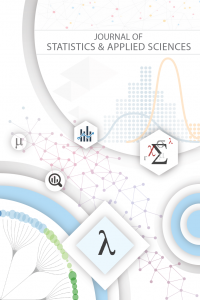Klasik Kanada Lynx Verileri İçin Önceden Bulunmuş Zaman Serisi Modellerinin K-Means Küme Yöntemi ve BDS Testi ile İncelenmesi
Kanada vaşağı verileri literatürde yaygın olarak kullanılmaktadır ve modellenmiştir. Bugüne kadar pek çok farklı model yapılmış olmasına rağmen, bu modeller arasındaki benzerlik veya farklılıkların araştırılması için artıklar açısından model tabanlı sınıflandırma çalışmaları yapılmamıştır. Bu çalışma, Kanada vaşak zaman serileri için daha önce elde edilen modelleri gözden geçirdi. Mevcut çalışmanın çıkış noktası artıklardır ve bunun için bazı istatistiksel veri analiz araçları kullanılmaktadır. Modellerin artık serileri, K-means kümeleme yöntemi ile kümelenir. Ayrıca bu zaman serisi için yeni bir model önerilmiş ve model literatürdeki diğer modellerle birlikte veri analizine dahil edilmiştir. Ayrıca modellerin tüm artık zaman serileri için kaos analizi yapılmıştır.
Anahtar Sözcükler: Zaman serileri, K-means küme yöntemi, BDS Test İstatistiği, Kanada vaşak verileri
Anahtar Kelimeler:
Zaman serileri, K-ortalama kümeleme yöntemi, BDS test istatistiği, Kanada lynx verisi
Examination of Pre-Founded Time-Series Models for Classic Canada Lynx Data by K-Means Cluster Method and BDS Test
Canadian lynx data are widely used and modeled in the literature. Although many different models have been made so far, no model-based classification studies have been carried out in terms of residuals to investigate the similarities or differences between these models. This study reviewed previously obtained models for the Canadian lynx time series. The starting point of the current study is residuals, and some statistical data analysis tools are used for this. The residual series of the models are clustered with the K-means cluster method. Besides, a new model is proposed for this time series, and the model is included in the data analysis together with other models in the literature. In addition, chaos analysis was performed for all residual time series of the models.
___
- [1] Box, G.E.P., Time Series Analysis: Forecasting and Control 1994, Englewood Cliffs, N.J. Prentice Hall.
- [2] Cendejas-Zarelli, S., “Annual Canadian Lynx trappings 1821-1934”, https://rstudio-pubs-static.s3.amazonaws.com/168257_373a84b37 f48453dad40cbc708f 670ff.html, 2016.
- [3] Karnaboopathy, R. and Venkatesan, D., “Data mining in canadian lynx time series”, Journal of Reliability and Statistical Studies; ISSN: 0974-8024, (Online):2229-5666, 2012; 5(1): 1-6.
- [4] Moran, P.A.P., “The statistical analysis of the Canadian lynx”, Australian Journal of Zoology, 1953; 1: 163-173.
- [5] Tong, H. and Dabas, P., “Cluster of time series models: an example”, Journal of Applied Statistics, 1990; 17(2): 187-198.
- [6] Tong, H., “Some comments on the Canadian lynx-with data-with discussion”, Journal of Royal Statictical Society, A, 1977; 448-468.
- [7] Gabr, M.M. and Subba Rao, T., “On the Identification of Bilinear Systems from Operating Records”, IFAC Proceedings 1981; 15(1): 375-380.
- [8] Ozaki, T., “The statistical analysis of perturbed limit cycle processes using non-linear time series models”, Journal of Time Series Analysis, 1982; 3: 29-41.
- [9] Tong, H., Threshold Models in Nonlinear Time-Series Analysis. 1983, Springer-Verlag, New York.
- [10] Subba Rao, T., “Contribution to the discussion of Tong and Lim’s paper”, Journal of the Royal Statistical Society, B, 1980; 278-280.
- [11] Lai, D., “Comparison study of AR models of the Canadian lynx data: A close look at BDS statistic”, Computational Statistics & Data Analysis, 1996; 22(4): 409-423.
- [12] Kaboudan, M.A., “Genetically evolved models and normality of their fitted residuals”, Journal of Economic Dynamics and Control, 2001; 25(11): 1719-1749.
- [13] Terui, N. and Van Dijk H. K., “Combined forecasts from linear and nonlinear time series models”, International Journal of Forecasting, 2001; 18(3): 421-438.
- [14] Khashei, M. and Bijari, M., “A new class of hybrid models for time series forecasting”, Expert Systems with Applications, 2012; 39(4): 4344-4357.
- [15] Chavas, J., “Modeling population dynamics: A quantile approach”, Mathematical Biosciences, 2015; 262, 138-146, 2015.
- [16] Zainuddin, N.H., Lola, M.S., Djauhari, M.A.,Yusof, F.,Ramlee, M.N.A., Deraman, A., Ibrahim, Y., Abdullah, M.T., “Improvement of time forecasting models using a novel hybridization of bootstrap and double bootstrap artificial neural networks”, Applied Soft Computing, 2019: 105676.
- [17] Panigrahi, S., Behera H.S., “A study on leading machine learning techniques for high order fuzzy time series forecasting”, Engineering Applications of Artificial Intelligence, 2020; 87: 103245.
- [18] Chen, W., Xu, H., Chen, Z., Jiang, M., “A novel method for time series prediction based on error decomposition and nonlinear combination of forecasters”, Neurocomputing, 2021; 426 (22): 85-103.
- [19] Kasap, R. And Kurt, E., “An Analysis on Modeling with Different Approaches for the Same Time Series”, National Statistics Symposium 2000; 27-28 April, Ankara.
- [20] Hardle, W., Hlavka, Z. “Multivariate Statistics: Exercises and Solutions”, Springer 2007.
- [21] Johnson, R.A., Wichern D.W. Applied Multivariate Statistical Analysis 2002, 5.th Edition, Prentice Hall, 2002.
- [22] MacQueen, J.B., “Some Methods for Classification and Analysis of Multivariate Observations. In: Proceedings of the 5th Berkeley Symposium on Mathematical Statistics and Probability”, Volume 1: Statistics, University of California Press, Berkeley, 1967; 281-297.
- [23] Anderson, T.W. An Introduction to Multivariate Statistical Analysis. 1984, Second Edition, John Wiley&Sons, New York.
- [24] Mirkin, B., Mathematical Clasification and Clustering. 1996, Kluwer Academic Publisher, London.
- [25] Grassberger, P. & Procaccia, I. Characterization of strange attractors. Physical review letters, 1983; 50(5): 346.
- [26] Brock, W. A., Brock, W. A., Hsieh, D. A. & LeBaron, B. D. Nonlinear dynamics, chaos, and instability: statistical theory and economic evidence. 1991, MIT press.
- [27] Chappell, D., Padmore, J. and Ellis, C. A note on the distribution of BDS statistics for a real exchange rate series. Oxford Bulletin of Economics and Statistics, 1996; 58: 561–565.
- [28] Kasap, R. and Kurt, E., An investigation of chaos in RL-diode circuit by using the BDS test Journal of Applied Mathematics Decision Sciences 1998; 2(2): 193-199.
- [29] Tong H. Non-linear time series: a dynamical system approach. 1990, Oxford University Press, Oxford.
- [30] Modiri, M., Homayounpour, M.M. & Ebadzadeh, M.M. Reservoir weights learning based on adaptive dynamic programming and its application in time series classification. Neural Comput & Applic 2022; 34: 13201–13217. https://doi.org/10.1007/s00521-021-06827-5
- Yayın Aralığı: Yılda 2 Sayı
- Başlangıç: 2020
- Yayıncı: Abdulkadir KESKİN
Sayıdaki Diğer Makaleler
Sağlık Kurumlarında Kriz Yönetimi: Bir Kamu Hastanesi Örneği
